 Kalliope’s
Comments
(group member since Aug 28, 2018)
Kalliope’s
Comments
(group member since Aug 28, 2018)
Kalliope’s
comments
from the Ovid's Metamorphoses and Further Metamorphoses group.
Showing 221-240 of 610
 Jim wrote: " the story told and the act of telling it are bound up so closely that in telling the story,..."
Jim wrote: " the story told and the act of telling it are bound up so closely that in telling the story,..."I agree entirely with this, and that is why having to deal with translations is sometimes so frustrating.
 Jim wrote: "I perceive the Met as being consciously self-referential from the very first lines; Ovid declares his intention to relate the entire history of creation, with the pervasive theme of transformations..."
Jim wrote: "I perceive the Met as being consciously self-referential from the very first lines; Ovid declares his intention to relate the entire history of creation, with the pervasive theme of transformations..."Jim, we have an ongoing cycle of lectures on Fantasy in Art in the Prado, and one of the speakers dedicated his lecture to the Egyptians. He spoke of the Ouroboros amongst other 'fantastic' figures, but I had entirely forgotten about it until you mentioned it in your post.
Thank you.
And I agree about the self-refentiality as the ongoing dynamic force within the Met.
 Historygirl wrote: "
Historygirl wrote: "HG, you mean in the discussion in this Group? I c..."
Yes, that chapter 5 with the embedded stories is a very striking one. I guess it inspires us all. Thank you, HG.
 Historygirl wrote: "I appreciated some good threads in Book 5 discussion. I believe Islet posted several in-depth comments.
Historygirl wrote: "I appreciated some good threads in Book 5 discussion. I believe Islet posted several in-depth comments. ..."
HG, you mean in the discussion in this Group? I cannot identify Islet...
 Elena wrote: "my understanding is that the educated classes saw the gods' stories as allegories for fate...although offerings were apparently still a very good idea..."
Elena wrote: "my understanding is that the educated classes saw the gods' stories as allegories for fate...although offerings were apparently still a very good idea..."Yes, the offerings could be understood as an exercise in humbling oneself.
 There are more Marsyas paintings, but yesterday I was meeting friends at the Prado coffeeshop, and inevitably I then went to their bookshop. Inevitably, again, I bought a book.
There are more Marsyas paintings, but yesterday I was meeting friends at the Prado coffeeshop, and inevitably I then went to their bookshop. Inevitably, again, I bought a book.It was on Tintoretto, and glancing through its pages I found this.
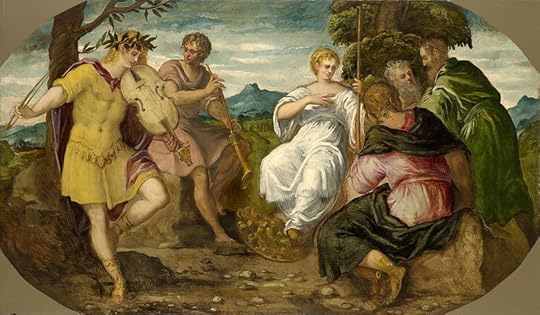
Tintoretto. The Contest of Apollo and Marsyas. 1544-45. Wadsworth Atheneum Museum.
One can see that it is an early Tintoretto, and painted well before Titian did his (post #59 above). An amiable rendering of the beginning of the episode.
 Desirae wrote: "
Desirae wrote: "Marsyas was flayed alive, not because of his music, but by challenging Apollo's role; .."
I agree, Desirae. Similarly with Arachne.
 It seems I can post again a few images. This painter has two scenes out of the story, the more amiable one and the bloody and final one.
It seems I can post again a few images. This painter has two scenes out of the story, the more amiable one and the bloody and final one.Filippo Lauri. 17C. Unknown.
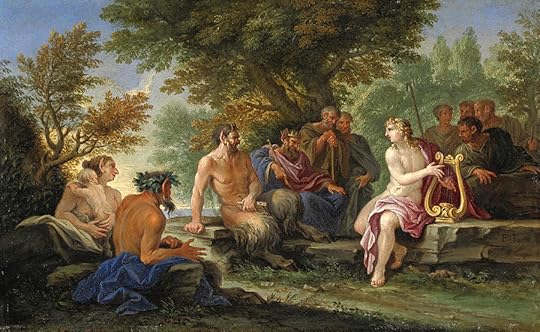
The more gory stage:
Filippo Lauri. 17C. Louvre.
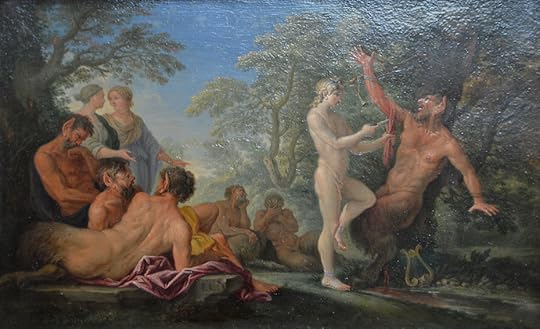
 Vit wrote: "The tale of Tereus, Procne and Philomela is something like a horror mystery told in the goriest hues.
Vit wrote: "The tale of Tereus, Procne and Philomela is something like a horror mystery told in the goriest hues.“But soon her tongue the girding pinchers strain,
With anguish, soon she feels the piercing pai..."
Yes, my notes expand on this, inquiring why would Ovid relish on the descriptions of the gory aspects. Whether it is 'a concession to the taste of the Roman Republic' but we are reminded of the cruelty also in Elizabethan drama, with Shakespeare's Titus Andronicus ranking well high up.
 With Marsyas we come to a second episode of an artist being punished. This is a very gory story.
With Marsyas we come to a second episode of an artist being punished. This is a very gory story.This one by Titian I saw recently in an exhibition in Madrid. It was daunting.
Titian. Flaying of Marsyas. 1570-76.
Kroměříž Archdiocesan Museum, Czech Republic.

And here is a detail:

There are many paintings with this theme which raises questions about our culture and its fascination with violence. Many are by painters not so well known today but who probably were during their lifetime. Similarly to the theme of Latona, popular (possibly during late Renaissance and Baroque) but falling out of fashion.
I have a few more to post but I am having some issues with the computer. Will try again later.
 This book is very interesting also in the role of the Narrator - we are presented with a series of 'unidentified' narrators: 'one of them', 'someone else'...
This book is very interesting also in the role of the Narrator - we are presented with a series of 'unidentified' narrators: 'one of them', 'someone else'...And we are also drawn to the power of narrative itself - how stories lead to (earlier) stories...
As I am tracking the way Ovid links together these various narratives, I now keep thinking of RC's point in that Ovid is not too interested in separating them...
 Beth wrote: "
Beth wrote: "http://thegreekobserver.com/greece/cu......"
Thank you, Beth... This is interesting indeed. A good turn around.
 I am fishing out the images included in the link I included in my post #48 - On Latona and the Farmers.
I am fishing out the images included in the link I included in my post #48 - On Latona and the Farmers.More comfortable for every one. But the page is still worth visiting for the comments on the images.
Tintoretto. 1545-48. Courtauld Institute.
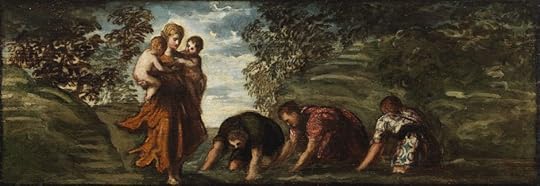
Annibale Carracci. Second half 16C. Arcidiecézní muzeum Kroměříž.

Jan Brueghel the Elder. 1595-1610. Rijksmuseum.

A detail:

Francesco Trevisani . End 17C - early 18C. Private.

François Lemoyne. 1721. Portland Art Museum.

Unindentified Artist. c 1750. Unkown location.
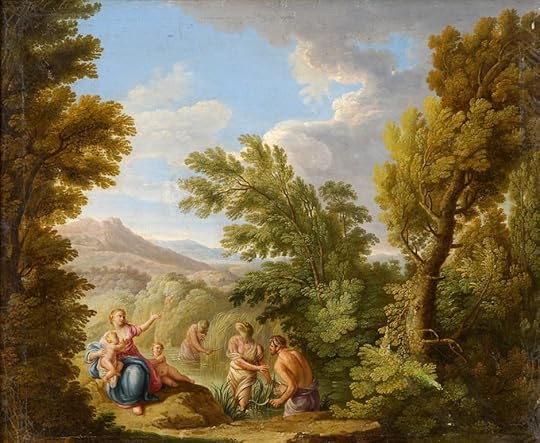
Gabriel Guay. Latona and the Peasants. 1877. Château du Roi René, Peyrolles, Provence.

 Desirae wrote: "Athena's creation is nothing but a propaganda tool to submit towards "divine" authority; yet, Arachne displayed reality. Immortals can be just as cruel within the mortal realm and are able get away with anything
Desirae wrote: "Athena's creation is nothing but a propaganda tool to submit towards "divine" authority; yet, Arachne displayed reality. Immortals can be just as cruel within the mortal realm and are able get away with anything..."
Yes, Arachne's work comes across as much more interesting.
Arachne can still weave but cannot relay the atrocities of the Olympiads; mortality is forfeited by voicing her opinion.
I agree, another case of impairing and controlling speech.
 Roman Clodia wrote: "is 'allowed' to keep weaving but it's her capacity to tell stories via weaving that is taken away - story-telling, this poem repeatedly shows, can be risky and dangerous to the teller.
Roman Clodia wrote: "is 'allowed' to keep weaving but it's her capacity to tell stories via weaving that is taken away - story-telling, this poem repeatedly shows, can be risky and dangerous to the teller. ..."
Yes, all individuality is taken away from Arachne.
What strikes me about this episode is the real reason why Minerva decides to go after Arachne. She got all excited with the account of the Muses and needs to go and vent her anger onto someone, and so she remembered Arachne - for 'she had heard' (rumours) that she had defied the divine power.
But I see an ambivalent portrayal of Arachne. I think she first engages the empathy of the reader, but then she spoils things for being too stubborn.
 Below a few paintings with the Latona and the Lycian Farmers. This topic in painting was new to me.
Below a few paintings with the Latona and the Lycian Farmers. This topic in painting was new to me.In this one the frogs are included.
David Teniers the Younger. 1640-50. San Francisco Fine Arts Museums.

In the one below, Latona's kids look like small adults.
Johann-Georg Platzer. circa 1730. Minneapolis Institute of Art.
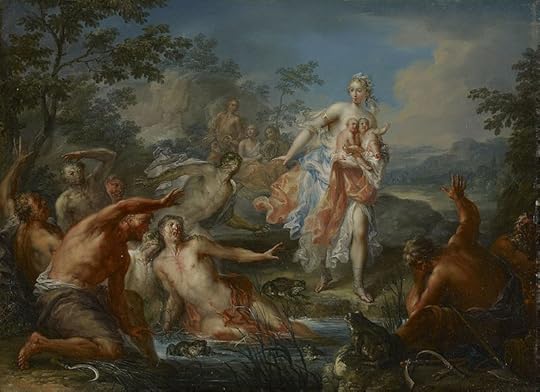
I found the following article that states that this myth is sort of forgotten but that in the past it was very popular leaving several paintings.
The article includes them. I may post them here later today, individually, because it makes it easier. But the article has a good discussion.
https://eclecticlight.co/2017/06/23/c...
 At the end of the Niobe episode, I have been somewhat taken aback by the 'narrator'... We have 'the people' then 'one of them' and then we move to a first person narrative.
At the end of the Niobe episode, I have been somewhat taken aback by the 'narrator'... We have 'the people' then 'one of them' and then we move to a first person narrative.I will check other editions to see if this becomes more clear. Anybody?
 A few more paintings on the killing of Niobe's children.
A few more paintings on the killing of Niobe's children.Jan Boeckhorst. 1630. Antwerp Royal Museum.
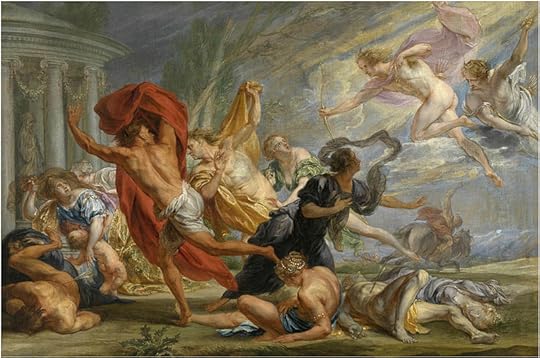
I like this one. I like the movement. Niobe dressed in mourning already.
Below a very sketchy sketch:
Tintoretto (school of). Second half 16C. The Courtauld Gallery.
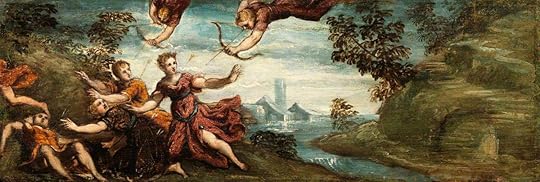
 Kalliope wrote: "Pierre-Charles Jombert. 1722. Unknown. ..."
Kalliope wrote: "Pierre-Charles Jombert. 1722. Unknown. ..."I have found a study for the Jombert. It is in the Metropolitan Museum.

From the Museum I learn that Jobert wan the 'Prix de Rome' with this painting in 1772.

